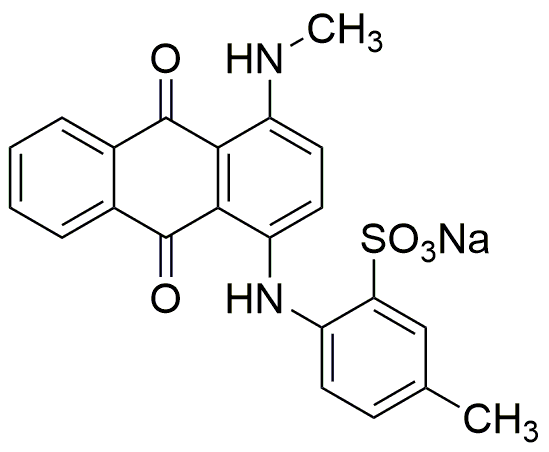Alizarin astrol is widely utilized in research focused on:
- Dyes and Pigments: This compound is used in the textile industry for producing vibrant colors in fabrics, offering excellent lightfastness and washfastness compared to other dyes.
- Biological Staining: In histology and microbiology, it serves as a staining agent, helping researchers visualize cellular structures under a microscope, which is crucial for diagnostics and research.
- Analytical Chemistry: Alizarin astrol is employed in various analytical methods to detect metal ions, providing a reliable and sensitive approach for environmental monitoring and quality control in manufacturing.
- Cosmetic Formulations: Its natural origin and vibrant color make it a popular choice in cosmetic products, enhancing the aesthetic appeal while being safer than synthetic alternatives.
- Art and Craft Materials: Artists use this compound in paints and inks, benefiting from its rich hue and stability, making it ideal for both professional and amateur applications.
General Information
Properties
Safety and Regulations
Applications
Alizarin astrol is widely utilized in research focused on:
- Dyes and Pigments: This compound is used in the textile industry for producing vibrant colors in fabrics, offering excellent lightfastness and washfastness compared to other dyes.
- Biological Staining: In histology and microbiology, it serves as a staining agent, helping researchers visualize cellular structures under a microscope, which is crucial for diagnostics and research.
- Analytical Chemistry: Alizarin astrol is employed in various analytical methods to detect metal ions, providing a reliable and sensitive approach for environmental monitoring and quality control in manufacturing.
- Cosmetic Formulations: Its natural origin and vibrant color make it a popular choice in cosmetic products, enhancing the aesthetic appeal while being safer than synthetic alternatives.
- Art and Craft Materials: Artists use this compound in paints and inks, benefiting from its rich hue and stability, making it ideal for both professional and amateur applications.
Documents
Safety Data Sheets (SDS)
The SDS provides comprehensive safety information on handling, storage, and disposal of the product.
Product Specification (PS)
The PS provides a comprehensive breakdown of the product’s properties, including chemical composition, physical state, purity, and storage requirements. It also details acceptable quality ranges and the product's intended applications.
Certificates of Analysis (COA)
Search for Certificates of Analysis (COA) by entering the products Lot Number. Lot and Batch Numbers can be found on a product’s label following the words ‘Lot’ or ‘Batch’.
*Catalog Number
*Lot Number
Certificates Of Origin (COO)
This COO confirms the country where the product was manufactured, and also details the materials and components used in it and whether it is derived from natural, synthetic, or other specific sources. This certificate may be required for customs, trade, and regulatory compliance.
*Catalog Number
*Lot Number
Safety Data Sheets (SDS)
The SDS provides comprehensive safety information on handling, storage, and disposal of the product.
DownloadProduct Specification (PS)
The PS provides a comprehensive breakdown of the product’s properties, including chemical composition, physical state, purity, and storage requirements. It also details acceptable quality ranges and the product's intended applications.
DownloadCertificates of Analysis (COA)
Search for Certificates of Analysis (COA) by entering the products Lot Number. Lot and Batch Numbers can be found on a product’s label following the words ‘Lot’ or ‘Batch’.
*Catalog Number
*Lot Number
Certificates Of Origin (COO)
This COO confirms the country where the product was manufactured, and also details the materials and components used in it and whether it is derived from natural, synthetic, or other specific sources. This certificate may be required for customs, trade, and regulatory compliance.


